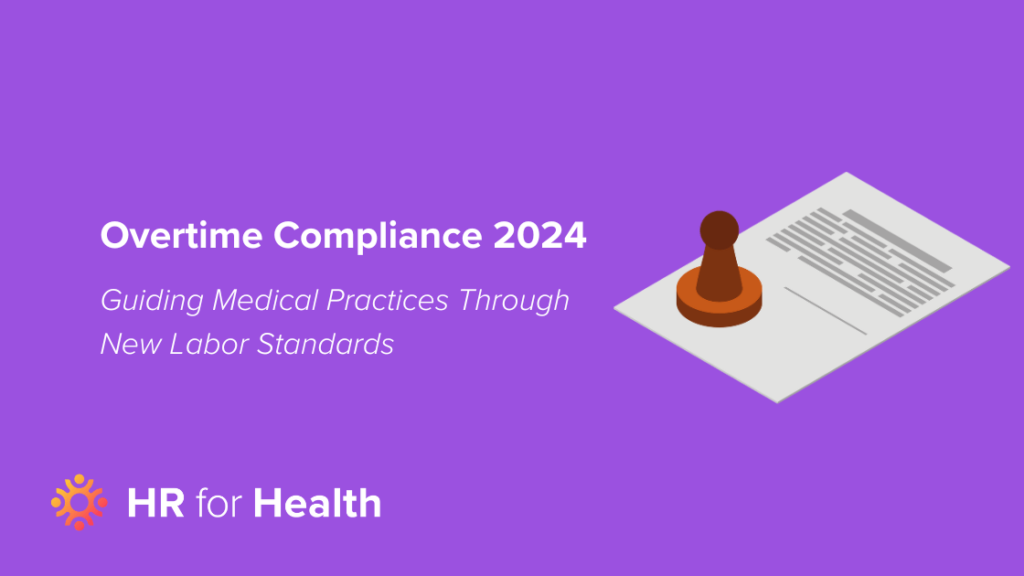On April 23, 2024, the U.S. Department of Labor issued a critical update to the regulations defining overtime eligibility under the Fair Labor Standards Act (FLSA). This new rule is poised to expand overtime protections to approximately 4.3 million workers, significantly impacting several sectors including healthcare. As a medical practice owner, understanding the implications of this rule is essential for managing your staff effectively and ensuring compliance.
Understanding the New Overtime Rule
The overtime rule primarily affects salaried employees earning below a specified threshold, who are entitled to 1.5 times their regular pay for hours worked beyond 40 per week. The new regulations will increase the salary threshold in two phases:
- Effective July 1, 2024: The threshold will be raised to $844 per week ($43,888 annually).
- Effective January 1, 2025: The threshold will increase to $1,128 per week ($58,656 annually).
These changes aim to correct the outdated thresholds that have not kept pace with wage growth and inflation, ensuring more workers are compensated fairly for overtime.
New Overtime Rule Impact on Medical Practices
Medical practices often employ a variety of administrative and professional staff whose duties may classify them under the executive, administrative, or professional (EAP) exemption categories. With the new rule, many employees previously exempt might now qualify for overtime pay. This includes roles such as office managers, senior administrators, and possibly some specialized non-clinical staff.
Strategic Adjustments for Practice Owners
- Workforce Audit: Review the employment contracts and pay scales of your salaried employees to determine who will be affected by the new thresholds. Consider the number of hours these employees currently work and how often they exceed the 40-hour mark.
- Financial Planning: Assess the potential increase in labor costs due to the new overtime rules. This may affect your budgeting and financial strategies, possibly requiring adjustments to staffing or hours to manage increased payroll expenses.
- Policy Updates: Update your payroll policies and communicate these changes to your staff clearly. Ensure that all payroll practices are compliant with the new rules and that your employees understand their rights and obligations under the new structure.
- Leverage Technology: Consider implementing advanced scheduling and time-tracking technologies to accurately monitor hours worked and manage staffing efficiently. Automation can reduce the risk of unintentional non-compliance and help optimize labor costs.
- Consultation: Engage with a labor attorney or a human resources expert specializing in healthcare to navigate the complexities of the FLSA and ensure that your practice remains compliant without sacrificing operational efficiency.
To further streamline your compliance efforts, consider HR for Health, our dedicated HR software designed for healthcare practices. HR for Health automatically ensures you’re compliant with local, state, and federal minimum wage and overtime laws. With our software, you never have to worry about keeping up with changing requirements or calculations around compensation for minimum wage or overtime. We handle it all for you, simplifying your operations and allowing you to focus on providing top-notch care.
The updated overtime rule represents a significant shift in labor law that will affect many medical practices across the country. By taking proactive steps to understand and implement these changes, practice owners can ensure they continue to operate effectively while providing fair compensation to their employees. Remember, this is not just about compliance; it’s also an opportunity to review and improve your operational and human resources strategies, enhancing overall productivity and staff morale in your practice.
FAQs: Understanding the New Overtime Rule for Medical Practice Owners
Q1: What is the new salary threshold for overtime eligibility according to the Department of Labor’s latest rule?
A1: Effective July 1, 2024, the salary threshold for overtime eligibility will be raised to $844 per week, or $43,888 annually. This will further increase to $1,128 per week, or $58,656 annually, starting January 1, 2025.
Q2: How many workers are affected by this new rule?
A2: The new rule will extend overtime protections to approximately 4.3 million workers, enhancing the compensation for hours worked over 40 in a week.
Q3: What are the criteria for an employee to be classified as exempt from overtime under this new rule?
A3: Employees who earn above the new salary thresholds may still be exempt if their job duties primarily involve executive, administrative, or professional tasks as defined by the Fair Labor Standards Act (FLSA).
Q4: How often will the overtime salary threshold be updated under this new rule?
A4: The salary threshold will be updated automatically every three years, ensuring the threshold keeps pace with economic changes and wage growth.
Q5: How will the new rule impact medical practices specifically?
A5: Medical practices may see an increase in payroll expenses for staff whose salaries fall below the new threshold and who work more than 40 hours per week. This includes potentially administrative and some non-clinical staff.
Q6: What steps should medical practice owners take to prepare for these changes?
A6: Practice owners should review their current payroll to identify which employees will be affected by the new thresholds, assess the potential financial impact, and consider adjusting their staffing and scheduling practices accordingly.
Q7: What are the benefits of the new overtime rule for workers?
A7: The rule is designed to ensure fair compensation for overtime work, thereby reducing the burden of unpaid extra hours and improving overall worker well-being.



